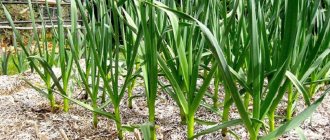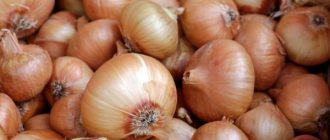Garlic is a fairly hardy crop, so it can be grown in Siberia without any problems.
Dear readers! For you, we have created communities on social networks in which useful articles and interesting ideas are published several times a day! Subscribe and receive useful content in a convenient format!
However, the harsh Siberian climate leaves its mark on the procedure.
Today we will talk about the features of autumn planting garlic in Siberia.
Features of planting garlic in autumn in Siberia
The main feature of planting in Siberia is that the procedure is carried out much earlier than in the rest of Russia. Tentative dates: September 14 – October 14.
But in general it is believed that it is optimal to plant cloves 45-50 days before the arrival of frost.
The second feature of growing garlic is the choice of variety. Preference should be given to frost-resistant winter varieties. For example, Siberian shooter, Nadezhny, Alcor, Skif, Gribovsky Yubileiny, Elenovsky, etc.
Also, be sure to mulch the garden bed. This will create additional cover for the planted cloves.
If possible, monitor the level of snow in the garden throughout the winter and add more if necessary.
Varieties for the climate of Siberia
The regions of Siberia are characterized by late spring and early onset of autumn cold weather, so varieties and hybrids of winter garlic that are resistant to temperature fluctuations have been developed specifically for this climate. When choosing a variety, you need to compare the length of the growing season with the weather conditions of the area.
For areas with frosty winters and late spring, early and mid-ripening varieties are suitable, but if the summer is not very short, then late-ripening varieties are also planted. According to the observations of gardeners, heads with purple colored scales are more resistant to frost and less demanding to care for.
Popular varieties (growing season indicated in brackets):
- Gradekovsky, Novosibirsk (85 days);
- Lyubasha, Skif (85-90);
- Bashkirsky 85 (90);
- Alcor (95);
- Siberian marksman (95-100);
- Sofievsky (100);
- Dobrynya (100-110);
- Reliable (100-120);
- SIR-10 (115-125).
What varieties of garlic can be planted before winter in Siberia
The cold climate of the Siberian region is a serious test for any wintering crops. Garlic is no exception.
When planting cloves in the fall, it is necessary to select special zoned varieties. Breeders have developed many varieties of garlic that are more adapted to the climatic conditions of a particular region.
Summer residents of Siberia should pay attention to the following varieties: Alcor, Spas, Nadezhny, Skif, Gribovsky Yubileiny, Novosibirsky 1, Lyubasha, Sofievsky, Sibirsky.
ON A NOTE. If this is your first time planting garlic in the fall, then buy planting material at a specialized store.
How to choose the right time to plant garlic in Siberia
Choosing the right time for the procedure is very important for obtaining a winter crop next year.
If you plant ahead of schedule, the teeth will sprout and will be “killed” by frost.
If planted too late, the ground will already be too cold and the garlic cloves will not be able to take root properly.
It is generally accepted to calculate it so that 7-8 weeks pass from planting to frost. When planting cloves, the soil should be about 10 degrees Celsius.
In each specific year, the exact time varies depending on the prevailing autumn weather in Siberia, but on average, the right time for planting garlic is the last days of September - the first days of October.
Moon landing - choosing timing
The technology for growing winter varieties involves planting 40-50 days before really cold weather sets in. By this time, the soil should have cooled to +10 °C - this temperature is sufficient for root growth and complete rooting. If the ground freezes, the plant will not be able to take root and will freeze.
Most often, the date for autumn planting falls on the second or third ten days of September or the first ten days of October, but due to the large territory of the Siberian region, it is not possible to talk about uniform dates. In northern latitudes, garlic is planted already in the second ten days of September, or even earlier; in some southern regions, planting is possible in the second or third ten days of October. In November, planting is not advisable, since there is not enough time for roots to form, frosts may strike, and the snow cover has not yet formed.
To determine a favorable time for planting, they rely on weather center forecasts, their own observations and the lunar calendar for bulbous crops, including garlic. The roots must take root before the ridge freezes, so the choice of timing must be taken responsibly.
On a note! Bulbous crops are planted and transplanted on the waning moon, when all vital forces are concentrated in the underground part of the plant. On the days you are in the sign of Aquarius, on the days of the Full and New Moon, the day before and the day after, it is better not to do plantings and transplants. If it was not possible to use a favorable day due to bad weather, then plant it at any time except the day of the Full and New Moon.
When to plant winter garlic in Siberia according to the lunar calendar in 2021:
| Month | Boarding days | Unfavorable days | Full Moon and New Moon Days |
| September | 7-15 | 4, 6, 18, 20-24 | 14-17 |
| October | 11-17 | 8-10, 17, 21-25 | 13-16 |
At what depth should garlic be planted before winter?
The depth of planting of cloves in the fall is no less important. If the planting material is too close to the surface, it may freeze.
If, on the contrary, the teeth sit too deep in the fall, then in the spring they will spend a lot of energy on germination, and the heads will be small.
The planting depth is calculated according to the size of the cloves being planted. Small ones should be planted to a depth of 7 cm, and large ones - up to 10 cm.
ON A NOTE. There is a simple formula for calculating planting depth. Add 5 to the length of the clove and get the optimal distance to the soil surface.
Soil preparation
In the fall you need to dig up the soil. Before this, add a bucket of compost and humus per 1 m2, about 1 tbsp. l. superphosphates and potassium, 1 tbsp. ash. To make the soil reaction neutral, add 200-300 g of fluff lime in the spring under the previous crop. For heavy soils and loams, it is recommended to add 1 bucket of sand and peat.
Winter garlic is grown in beds 15 cm high in increments of up to 1 m. This way the plants will warm up evenly on all sides. The rows are arranged from north to south so that the crop can receive enough sunlight in the summer. Prolonged cloudy weather significantly reduces yields.
The heads or cloves are laid out in trenches in 2 cm increments and sprinkled with well-loosened soil. The planting depth depends on the size of the planting material:
- large teeth – 6-7 cm;
- small – 3-4 cm.
If you do not plan to dig root crops in the coming autumn, then the distance between the cloves is increased to 4 cm. Planting too close can reduce the yield, the heads will be small. In addition, if the tops are located too close, they block the path of the sun's rays, and the root crops do not receive enough nutrients.
The teeth are seated in small grooves. A distance of 25-30 cm is left between the rows. Then the soil is mulched with humus or sawdust. Deep planting will promote rapid rooting of plants and protect against freezing. There is no need to forcefully press the planting material into the furrows; this will delay the formation of the root system.
Care is a very important point. To get a good harvest, you need to provide the plants with good care. If you live in a region with snowy winters, mulching the soil is not necessary at all. During the winter, you need to check whether the crops are well covered. If necessary, cover them additionally:
- sprinkle with last year's leaves;
- cover it with snow.
The first shoots of winter garlic appear in the spring, when the snow has not yet melted. The sprouts are pink-violet. While the soil has not yet warmed up, in the spring, it is fertilized with a nitrogenous solution. For 1 m2 you will need 1 tsp. urea.
Throughout the summer you need to loosen the soil and remove weeds. This will ensure optimal soil aeration. Garlic is a moisture-loving plant, so after the first shoots appear, the plantings are watered 3-4 times with an interval of 10-15 days for 1.5 months. Watering abundantly, water is poured into the row spacing. Then water the plants as needed.
After each watering and precipitation, you need to loosen the soil. This prevents the formation of a hard crust. Arrowing varieties shoot arrows in June. If the vegetable is grown for the purpose of collecting planting material for the next year, they are left until fully ripe; if not, they are removed. Removing shoots allows you to increase the weight of root crops by 40%.
At what distance should the crop be planted?
The distance between the cloves in the garden bed does not affect the winter hardiness of the plant, but it is also very important.
If planting is too frequent, the heads will turn out small. In addition, neighboring plants will take away each other's living space and compete for sunlight and food.
If the size of your plot allows, then leave a distance of 10-15 cm between the cloves. This way you will definitely provide each future plant with a normal amount of sunlight and nutrients in the soil.
Predecessors and preparation of beds
Here we need to make a small digression. I have 8 rows of strawberries - two each year. And two garlic too. After harvesting the garlic, I plant new rosettes of strawberries in its place, and it “moves” to two ridges that have been cleared of 4th year strawberries. In addition, I plant garlic in the space between the newly planted strawberries. The process will repeat next year. This is how garlic “walks” through the berry patch.
It should be noted that this is very convenient: I dig up old strawberries immediately after fruiting - around the beginning of August, which allows me to slowly prepare the beds for the autumn planting of garlic.
In August-September, when there is time, I dig up the ridges with a shovel over the bayonet, and at the same time I remove all the roots. Then I scatter Superphosphate and some potash fertilizer (a handful per linear meter of ridge) and the same amount of slaked lime (dust). It alkalizes the soil, which the wireworm really doesn’t like. Then I cover the fertilizer with a rake while leveling the surface. The beds are ready for planting.
Important! It is better to dig up the soil after the first frost, when the wireworm is just “getting ready” to go deeper into the lower layers of the soil. This makes it more likely that he will freeze.
I am devoted to the Gribovsky Jubilee variety. This is a large purple head with very large teeth. There are only 6-8 of them, less often 10. In principle, for planting you need to take only the outer cloves, but in this variety there are almost no internal ones.
* By the way, the varieties “Sbirsky”, “Novosibirsky”, “SIR-10” are also excellent for growing in Siberia.
Before starting planting, I fill the teeth with a dark crimson solution of potassium permanganate for 40 minutes.
Planting pattern: 20 cm row spacing and 12-15 cm in a row. My beds are not wide, about 80-90 cm. They are easier to care for. Thus, you get 4 rows of garlic with a distance of 10-15 cm from the edge.
I plant as follows: I either stretch the twine on two pegs, or I put a light long glazing bead (slat) so that the rows are even. Then I take one clove from a jar of potassium permanganate, and bury it bottom down with three fingers until the surface of the soil is at palm level (about 4-5 cm). I planted about 8 of them, leveled the holes, patted them with my palm and continued. If you pull two twines, then things will go faster.
When both beds are planted, I mulch them with a small layer of humus or compost soil (about 2 cm). No watering required. Spent 1 hour.
In young strawberry plantings, I plant garlic in one row in the center; I don’t fertilize it with anything in advance, since the beds were thoroughly prepared for the berries in July, but I do mulch them with humus. That's it, you can forget about garlic until spring. Snow will fall soon (50-70 cm) and he will be warm.
Read also: How to get rid of milkweed in the garden
I water it rarely (once every 10 days, provided there is no rain), but accurately - so that the moisture reaches the root layer (about 30 liters per sq.m.). After watering, as soon as the soil has dried slightly, I use a small caparul to slightly move it and break up the barely visible crust of dried soil. And I won’t go until the next watering. Of course, the sight of dry soil is scary, but all the moisture is inside, since it is not wasted on evaporation, so there are no cracks. The main thing is that with such loosening there are almost no weeds.
I feed phosphorus and potassium on July 10-20 so that the heads have time to ripen well (a month before harvesting). During the growing season, I periodically break out the arrows when they have reached a length of 5-10 cm (I cut them into 3 cm pieces, boil them in salted water, lightly fry them in sunflower oil and with ketchup - very tasty).
I dry it either in braids, or cut it so that the tail remains 5 cm.”
How to properly prepare a garden bed
To plant garlic in the fall, you need to choose a place so that the beds are illuminated by the sun and well ventilated.
There is no need to plant in lowlands in the fall. On the contrary, it is better to raise the bed slightly above the surface, since the accumulation of melt and groundwater can lead to the development of putrefactive processes in the garlic heads.
The beds are prepared 4-6 weeks before the expected planting date. The procedure consists of digging up the area to the depths of a spade bayonet and thoroughly weeding.
Fertilizers are also applied during this period. It is best to apply a prefabricated mixture of organic and mineral fertilizers. For example, per square meter of beds 1 bucket of humus + 30 g of superphosphate + 30 g of potassium sulfate.
Planting scheme for winter garlic
So, you have prepared the bed for planting. Now let's move on to the procedure itself.
Step 1. Sorting the teeth. Select approximately the same size to make a furrow of the required depth.
Step 2. Soak for half an hour in a weak solution of potassium permanganate. This prevents the development of fungal diseases.
Step 3. We make grooves with a row spacing of 30 cm. The depth of the grooves is from 7 to 12 cm, depending on the size of the planting material.
Step 4. Place the cloves bottom down, maintaining a distance of 10-12 cm.
Step 5. Cover with soil. We water it. We mulch.
When to plant garlic by region
The regions of our country differ from each other not only in geographical location, but also in climatic features. Therefore, planting garlic can occur in different months. It is necessary to embed the cloves in the ground 35-40 days before the arrival of stable frosts; this period is necessary for the rooting process.
In outskirts of Moscow
The Moscow region is located in the temperate continental climate zone. Frosty weather here sets in in early November. Accordingly, winter garlic will need to be planted at the latest in early October. In the time remaining before the arrival of winter, the crop will have time to form powerful roots and successfully overwinter. You can’t be late with planting, otherwise the cloves will simply freeze in winter, but planting garlic too early is dangerous, it can germinate in the fall, and then frost will kill the seedlings.
In the Leningrad region
The climate of the Leningrad region is known for its unpredictability and temperature changes. The planting date directly depends on weather conditions in the current season. Autumn here can be either early or late. Experienced gardeners usually draw up their own planting calendar based on long-term observations, in which they note temperature values at different times of the year.
This helps not to make mistakes with the planting lines for winter garlic. The spread of planting times in the Leningrad region is about 2 weeks. The suitable period lasts from mid to late September. If the weather is warm, you can delay planting until early October.
In Siberia
At the time of planting the cloves in the ground, the soil temperature should be +10° C. Over the next 40 days, roots will form. During this time, the roots grow up to 12 cm long. Since winter in the region can come quite early, garlic is planted here starting from the first days of September, adjusting the timing depending on current weather conditions.
In the Urals
The Ural region has a significant extent, and the arrival of winter here occurs at different times. The difference reaches 2 weeks or more. On average, we can say that negative temperatures are finally established in the period from October 20 to October 30. Therefore, winter garlic should be planted between mid and late September.
In the Far East
Garlic planting in the Far East and Primorye is carried out from the 20th of September to mid-October. If the weather is warm in the last days of September, postpone the date by another week to prevent untimely germination of the cloves. In the event that you failed to predict the weather, you played it safe and planted the garlic early, and it sprouted, fill the bed with sawdust when the night frosts arrive or cover it with agrofibre. The shelter will need to be left until spring.
Rules for caring for planted garlic before winter in Siberia
After planting garlic, it must be covered with dry grass, spruce branches or agrofibre. This is done so that the garlic does not freeze in the ground.
It is not advisable to water, as during early frosts the drops of water will freeze and damage the cloves.
In winter no care is needed. Later in the spring, after the soil has thawed, it must be loosened, and after the snow has completely melted, it must be fed with nitrogen-containing fertilizer.
You can use urea, but it is preferable to prepare a solution of mullein.
IMPORTANT! In the fall, after planting, do not feed garlic!
Caring for garlic in spring
Watering
The seedlings must be watered abundantly. If there is regular precipitation, this should be done once a week. In the absence of these, more often, preventing the soil from drying out and moisture stagnating. The intensity of watering decreases every day and stops completely 3 weeks before harvesting. After complete absorption of moisture, mulching is carried out with peat chips or a layer of humus (2 cm). Mulch will slow down the growth of weeds and conserve moisture. It will be possible not to loosen the soil; a crust will not form on it.
Weeding and loosening
Weeds need to be pulled out regularly; you should not allow a thick stem to form, otherwise there is a risk of pulling out the weed along with the head of garlic. Honey arrows should be removed immediately. Garlic needs systematic loosening of the soil to give oxygen access to the root system.
Top dressing
As soon as the first leaves appear on the garlic, it is necessary to fertilize. It is better to feed the plant with nitrogen. Mullein infusion is introduced into the beds. You can water the garden bed with urea. The second feeding should be in June - with an ash solution. Fertilizers will enrich the soil with microelements and potassium. It will also help prevent the development of pests and diseases of winter garlic.
What is the Siberian method of planting garlic?
Recently, the so-called “Siberian method” of planting garlic has become increasingly popular in Siberia. Its essence is that not individual cloves are planted, but whole heads of garlic are buried.
So, more about the method.
Step 1. At the most elevated place in the garden, you need to dig a hole about 2 shovels deep.
Step 2. We will lay a bedding of spruce branches at the bottom of the hole.
Step 3. Place a bag of garlic heads on top.
Step 4. The bag is covered with spruce branches.
Step 5. Fill the hole and compact the soil tightly.
Step 6. Place a peg so as not to lose the place.
Step 7. We dig the beds for planting garlic, and put the soil next to it.
Step 8. In the last ten days of April, we place organic fertilizers at the bottom of the bed and cover them with soil.
Step 9. After the soil has completely thawed, dig up a bag of garlic, separate the heads into cloves and plant them in prepared beds.
By this time, the teeth will already have hatched shoots and will quickly begin to grow. All further care is absolutely standard.
Common mistakes
- Fertilizing garlic with manure before planting. Because of this, the vegetable begins to actively grow tops, which is completely unnecessary before winter.
- Planting cloves in hollows. Melt water collects in them, which leads to rotting of the heads.
- Planting too deep in the fall. Because of this, the garlic goes deep and the head turns out small.
- Planting too close to the surface in autumn. If in the Middle Zone it is not critical to make a mistake in planting by a couple of centimeters, then in Siberia the frosts are much stronger. The garlic will freeze.
- Planting garlic too early or too late. Garlic cloves should be planted in Siberia when the average daily temperature fluctuates between +10 +12 degrees Celsius.
- The cloves are planted too often. Because of this, adult plants lack nutrition and light. The bulbs turn out small. Plants often get sick.
Site selection
First you need to choose a good, illuminated area with fertile soil. The site is fertilized before planting the previous plant. It is not recommended to plant garlic after potato crops, tomatoes, peppers, eggplants and onions. The crop is returned to its original place after 3-5 years. Root crops should be planted after garden crops that require heavy application of fertilizers:
The root crop grows well on soils with a slightly acidic or neutral reaction. The plant is demanding regarding the presence of nitrogen in the soil, but applying manure immediately before planting is not recommended. Quality indicators may suffer as a result. During overheating, the manure releases heat, due to which the garlic quickly forms the above-ground part, which leads to a decrease in the plant’s immunity.
The highest yields are observed on sandy loam soils and loams. Heavy soils are additionally fertilized with sand, rotted compost, and leaf humus. It is not recommended to plant the crop in areas with close groundwater.
Answers to frequently asked questions
When to plant garlic in Siberia?
Plant at the turn of September and October.
Does it make a difference which variety to take?
In general, all winter varieties are quite resistant to cold, but it is better to give preference to zoned varieties.
How deep should the cloves be buried?
On average it is about 10 cm.
At what distance should the landing be carried out?
Strive to ensure that there is 10-15 cm between future plants.
What should I put in the furrow when planting?
Nothing. Fertilizers are applied a month before planting.
Varieties suitable for Siberia
Winters in the northern regions are harsh and summers are short. For cultivation in Siberia, medium and early ripening varieties of garlic are chosen, because... winter comes early. Early ripening winter garlic is popular in the northern regions. Its growing season is 85 days. The following varieties are grown in Siberia:
- Bashkir 85. Plants form arrows. High resistance to fungal diseases is noted. The average weight of an onion is 70 g.
- Grodekovsky. The variety is intended for cultivation in the eastern part of Siberia. It is propagated by aerial bulbs. Productivity – up to 3 tons per 1 ha.
The growing season of mid-season types of winter garlic is 90-105 days. The following varieties are recommended for cultivation in the northern regions:
- Gribovsky Yubileiny. The variety is resistant to fungal diseases, low temperatures and drought. Average head weight – 55 g.
- Saved. The advantages of the crop are high shelf life, resistance to fusarium and nematode. Each head weighs 80-100 g.
- Alcor. Plants are resistant to yellow dwarf virus and fungus. The average weight of a bulb is 45 g. About 8 centners of crop can be harvested from 1 hectare.
- Novosibirsk. The variety is winter-hardy, immune to fusarium, and does not form shoots. Head weight – 30-35 g.
- Lyubasha. The variety tolerates frost and prolonged drought well. The yield of the variety is 3.5 tons per 1 ha. The bulbs retain their presentation for a long time. Their average weight is 120 g.
- Sofievsky. Plants are resistant to temperature changes. The bulbs are light purple, weighing up to 20 g. The harvest is well stored in winter.
- Dobrynya. Each head has 10-12 cloves. The main advantages are frost resistance and good keeping quality.
On a note! Gardeners have noticed that bulbs with a purple tint tolerate frost better. Plants are less demanding to care for.











